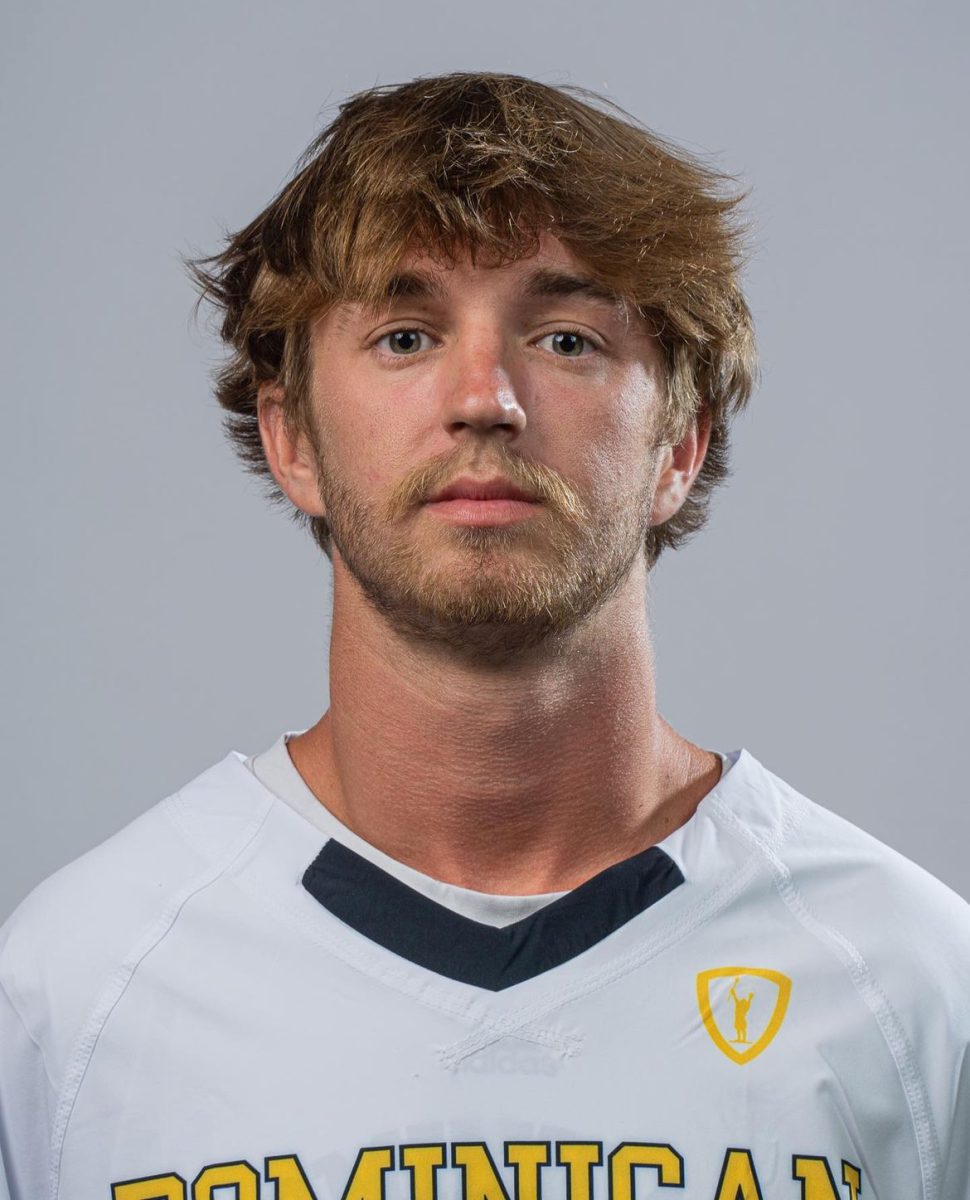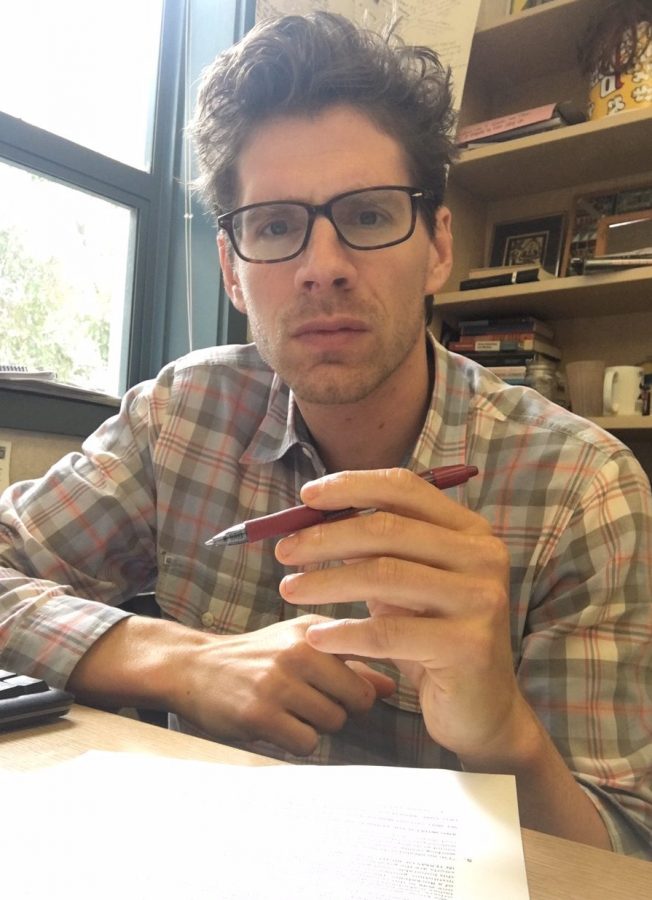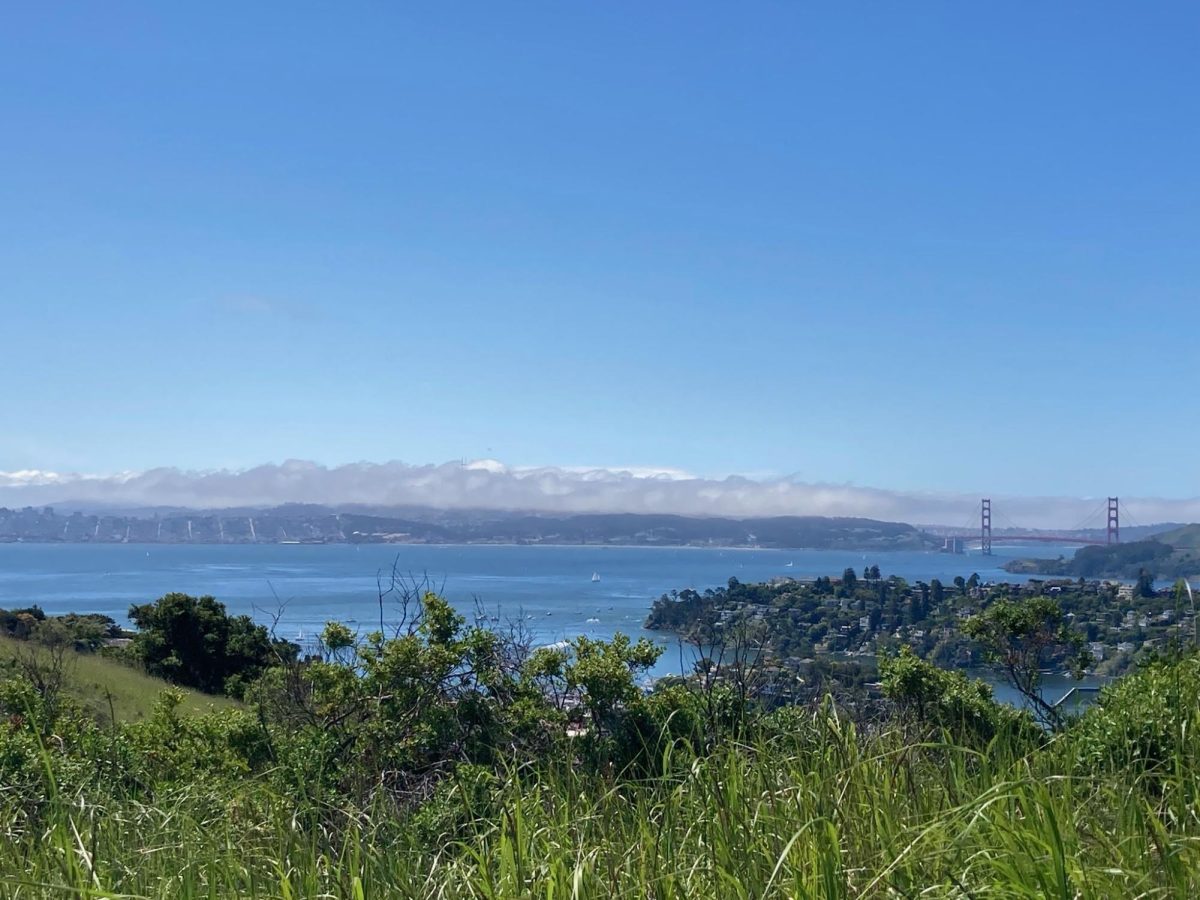The sun rises over all 502.4 square miles of Marin County to begin a new day. The morning light casts a golden glow encompassing the rolling hills of the Marin Headlands, streams through the redwood branches of Muir Woods, and glints off the salty water of Tomales Bay. The air is fresh. The ground is moist. You are lucky if you get to be present in the natural beauty of Marin.
Marin’s culture of participation in outdoor recreation fosters a love for the surrounding landscape. Dirt-splattered mountain bikes and sandy surfboards rest outside the houses of many Marin residents. Over 100 miles of trails cover Mount Tamalpais, the birthplace of mountain biking. Its earthy paths and scenic views are very attractive to competitive bikers and casual hikers alike.
The land is beautiful but humans are messy. Whether you like it or not, the health of the environment is greatly impacted by our usage of natural resources and landscapes.
“We as humans have an impact on what the world around us looks like,” says Harita Kalvai, class of 2023 from the Marin School of Environmental Leadership. “We cause a lot of issues, but we are also in charge of mitigating and solving them.”
Spanning the miles of Marin, people have stepped up to the challenge of lessening the impact on the environment. They aren’t just adult volunteers with extra time – they are also your classmates, friends, and students. These high schoolers’ common trait is their passion for being stewards of the land and taking on leadership roles to improve the environment. For them, environmental protection is not just an afterthought.
“People should care about the environment because, well, why wouldn’t you?” says SRHS sophomore Leo Nnuch, founder of the SRHS Coastal Cleanup Club.
High school students are ambitious – they’re excited about the sheer amount of possibilities that the world has for them. Leadership is not just inside the classroom. For these students, it extends to serving the land that they grew up living in.

MSEL students in their semester-long project group. Credit: Harita Kalvai
Harita Kalvai, through the Marin School of Environmental Leadership (MSEL), decided to initiate change in her community. Partnering with Safe Routes to School, a national organization, she worked to increase the amount of students walking and biking to school. Kalvai wanted to convey to Marin that it was safe for people to take public transportation during COVID-19’s peak. She helped produce a video outlining the safety features of the Marin transit, which was advertised on the MSEL website for a couple of months.
According to the U.S. Environmental Protection Agency, the average passenger vehicle emits 4.6 metric tons of carbon dioxide per year and cars make up about 28% of all U.S. carbon dioxide emissions. But it’s not the gasoline itself that makes up most of the carbon dioxide weight emitted from vehicles – it’s actually the oxygen in the air. Carbon and hydrogen separate when gasoline burns. When combined with oxygen, hydrogen turns into water while carbon turns into carbon dioxide.
In order to bring about change, you have to be willing to take on responsibility. That’s how Kalvai found herself a student of MSEL. Based out of Terra Linda High School in San Rafael, MSEL is a program where students work together with outside organizations to create solutions for or make people aware of environmental issues.
“I really liked the idea of project-based learning and getting to work on things that had a real-world impact,” says Kalvai. “I also wanted an experience of a smaller environment and I thought it would be interesting to work with people who have the same interest as me.”
While a student of MSEL, Kalvai found herself learning much more than environmentalism. She found that environmental issues are interconnected with issues such as access to open spaces and environmental threats to low-income areas.
“It’s opened my eyes to intersectionality and how communities of people are affected in different ways by environmental issues,” she says. “I don’t think I would’ve made that connection in my head if MSEL hadn’t taught me about how environmental justice can be related to other social matters.”
Her senior year, she interned for the County of Marin. As someone looking to go into public policy, this was the perfect opportunity for Kalvai to experience actual policy-making firsthand. She attended board meetings, gave her opinions on different sustainability topics, and reached out to businesses to discuss their future plans for sustainability.
Kalvai knew from the beginning that she was interested in environmental action. But that’s not the case for everyone. Dylan Rodas, SRHS sophomore, was just looking for something to do over the summer. Linking Individuals to their Natural Community (LINC) sent a staff member to Rodas’s after school program in the Canal neighborhood to spread the word in hopes that students would apply.
“I decided to do LINC because it seemed like a lot of fun,” says Rodas. “The person that was giving the presentation seemed really happy to do it, and she seemed like she really cared about it.”
The program accepts 24 applications each year for six weeks in the summer. Students get an educational reward of $2,400 at the end. But that’s not the only thing keeping this program going. Its goal is to expose first generation, low-income, students of color to jobs in the environmental field to those who would not have access to the outdoors otherwise. LINC guided participants around the Bay Area to participate in trail work, open space restoration, and tending to native plants. They also monitor animals and insects to contribute to community science data that help the local scientists collect more than they would otherwise. Rodas says that “they showed us a lot about the environment and what we can do to make it better.”
Not only is LINC focused on environmental conservation, but also professional exposure.
Darryl Burton, LINC program director, sums up the professional component of LINC simply: networking, skills development, and experience. Students learn how to write resumes, practice job interviews, learn financial literacy, and get a feel for a general workplace environment. LINC has extensive professional networking with the Golden Gate National Parks Conservancy, where participants have a leg up on applying to jobs.
“The program gives valuable work experience to expand your resume, even if you’re not planning on going into the environmental field,” says Burton.
LINC took Rodas to Alcatraz to tend to the garden and adorned cards with flowers for prisoners. Over at SRHS, the Eco-Action Club is doing something similar: partnering with the Kindness Club to decorate vases and fill them with flowers from the school garden to give to teachers.
“All members of the Eco-Action Club are really kind and caring,” says Kent Morales, supervisor of the club. “They want to be leaders of change to create a better world.”

Sustainability is a fundamental principle in environmentalism, and gardens – no matter if it’s a backyard hobby or a community establishment – are a great example of this. Gardens attract pollinators like bees and hummingbirds, which encourage plant growth and protect biodiversity. And not only do plants absorb carbon from the air, but they also absorb carbon from the ground.
SRHS is among the 22.3% of U.S. high schools with a school garden. SRHS senior Isabel Sonneborn, the current president of the Eco-Action Club, is continuing the club’s goal of tending to the school garden. On the other side of the chain-link fence bordering Mission Street, a passerby sees rows of vibrant flowers bringing the planter boxes to life. This was once a dry, weedy ghost town. The COVID-19 pandemic stopped the world, including care for this garden. Now that schools have been back in person for over three years, enthusiastic students are heading the restoration of this green corner of campus. “We were able to make the garden into something new,” says Sonneborn.
“The Eco-Action Club decides what direction they want to go in based on what they’re interested in,” says Morales. “This year, the focus of the club has been on our school garden because it’s fallen into disrepair. They’ve been doing a good job of getting that going again.”

If it weren’t for this opportunity to revive the garden, Sonneborn would not have learned gardening skills otherwise. She, along with many other members of Eco-Action, learn to practice sustainable agriculture – how to grow, distribute, and dispose of produce.
Eco-Action drove the installation of compost, garbage, and recycling bins throughout campus. Unappetizing and unfortunate-looking food wasting away in the cafeteria is taken to Eco Action’s compost machine and repurposed for the garden. According to the U.S. Environmental Protection Agency, food is the most common material sent to landfills at 24.1% of all landfill materials, surpassing even plastics (18.5%). Composting improves soil quality, enabling our garden to thrive.
Eliza Gould, SRHS class of 2023 and predecessor to Sonneborn, participated in the production of a video through Eco-Action that demonstrated how to properly dispose of the school lunch items that students use every day. The video was shown to the whole school in hopes that it would actually encourage change on campus.
Word of mouth is an age-old form of communication that remains a very powerful tool. That’s how Gould and many others heard about the Eco-Action club. Shared interests among friends drew her in, coupled with her desire to have a positive impact on the world around her. After three years of being a member, Gould took on the role of president of the Eco-Action Club in the fall of her senior year in 2022.
“I just saw the opportunity to lead and took advantage of that,” she explains. “I couldn’t just wait for someone else to do it.”
This is true for any conservation project: it’s always the right time to begin. Sonneborn joined the Eco-Action Club her sophomore year because her friends’ older sisters were involved. She wanted to continue down her path of community service after doing Children for Change in middle school, and Eco-Action seemed to be a good fit.
“It makes me feel like I’ve had a positive impact on myself, my peers, and my community,” she says. “It just feels right.”

While the Eco-Action Club has been around for over 11 years, SRHS Coastal Cleanup Club, started by sophomore Leo Nhuch, began just this school year. Nhuch explains that he started this club to “bring friends together to solve a real issue in our community, as well as going to the beach more.” The gentle salty breeze and rolling waves reaching three miles of sandy shoreline at Stinson Beach lull in anyone, from surfers to relaxation-seekers to tourists who have never seen the beach before. It’s no wonder Coastal Cleanup Club’s first destination goal is Stinson.
Nhuch was inspired by an event put on by SRHS’s Interact Club (a community service club), where a group of students paddled kayaks along the San Rafael Canal to pick up as much trash as they could find.
“I saw from that event that there was a lot of trash in the Canal which I didn’t really know about, which is the reason I started this club: to inform people about this problem,” Nhuch explains.
Although the club is new, Nhuch has ambitious goals for the future. Anyone who wants to make any sort of difference in a community understands that change happens as action expands. It takes more than a couple change-seeking students to make an impact, but that’s where it all starts. Nhuch hopes to reach out to other schools to start coastal cleanup clubs throughout Marin to create a community web of environmental action networking.
“Together, with all these schools, Marin will really see a difference,” says Nhuch. “The more people we have working, the bigger difference we’re gonna see in our community.”
Gould took this philosophy to heart as president of Eco-Action. Environmentalism requires a certain kind of leadership: selfless and forward-thinking. She made sure to establish a legacy that could continue on without her. Instead of taking the glory of president for herself, she worked with the underclassmen to make sure everyone understood what it meant to work together, to be an environmental activist, and to push for change.
“I didn’t want the club to die because it couldn’t exist without me,” she says. “It was important to make sure that it didn’t ride on my shoulders so it could continue on.”
She describes the club’s impact as “fulfilling. The club inspires people and shows them that it’s possible to make a difference.”
Navigating environmental issues can seem overwhelming. That’s why Gould found that focusing in one area is the way to go.
“Narrowing down and making a big impact in a small way is really helpful,” says Gould. “Climate change and the environment are big issues, but finding just one niche subsection and actually being able to make an impact there is more attainable for a high school club.”
“One group of students isn’t going to solve climate change,” explains Harita Kalvai. “But, [at MSEL], we are given all the tools to learn how to address these issues no matter what field we [eventually] go into.”

Four-hundred-and eighty acres of tanned and dehydrated remnants of spring sway in the wind in the hills of Fairfax. Tamarancho, owned by Scouting America (previously the Boy Scouts of America), holds over 150 miles of mountain biking and hiking trails. Visitors travel through lush trees and stretching fields of amber grain to experience the refreshing outdoors.
A small lake nestles in the heart of Tamarancho’s campground. Bushels of cattails and weeds lurched into the lake’s hues of deep blue and green in the spring of 2020. Called upon by my scout troop, I ventured into this jungle with gardening gloves and a pair of loppers.
Spending four hours hunched over and hauling bundles of vegetation around made me feel something – physically exhausted, yes – but I felt pride in my work and accomplishment in seeing the visible difference it made.
Scouting America follows an oath called the “Outdoor Code” – a pledge to actively protect the environment. It goes as such:
“As an American, I will do my best to: Be clean in my outdoor manners; Be careful with fire; Be considerate in the outdoors; Be conservation minded.”
I find myself practicing these values as if they are second nature, repeated so many times between scouting events that they are engraved in my brain. Whether I’m immersed in the scent of pines through the famous Dipsea Trail or scooping the salty water on my stand-up paddle board in San Pablo Bay, the beauty of the outdoors draws me towards conservation.
Too many people have the same thought: “I can’t make change, I am just one person.” But a common
yet accurate cliche proves them wrong: all those people combined would make a difference. And nothing will happen if no one steps up.
That’s why these students do what they do. You might follow in the footsteps of these students, but helping to repair harm done to the local landscape doesn’t have to be time-consuming. Any action, no matter how small the scale, is one step closer to preserving our land. Get outside when you can. Sort your recycling. Pick up trash on the side of the road. Carpool and bike more. There are so many small measures to be taken that, when multiplied across individuals, communities, and regions, make a larger impact than one would think. Darryl Burton refers to an applicable saying: “Many hands make light work.”









































Sarah • May 29, 2024 at 11:16 am
Fabulous takes in here on the value of environmentalism and the power of a coalition. We all need a reminder every so often that everyone should do their part. Especially in a place like Marin which has so much natural beauty, it’s easy to forget that the glaciers are melting and that trash is flowing into the sea. Thanks Paige for a much-need read.